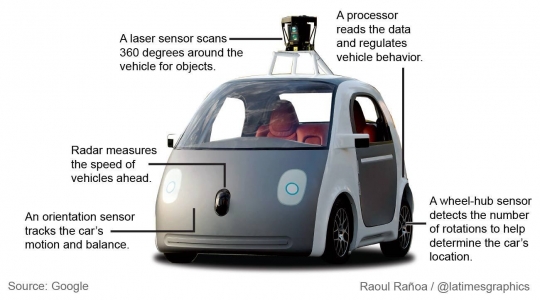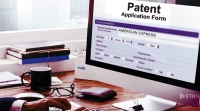
Here we see how the driverless car’s sensors identify the cyclist and his intent to turn right. (U.S. Patent and Trademark Office)
A year ago, Google made an impressive announcement. Its self-driving cars were capable of interpreting the hand signals of cyclists.
Google didn’t offer much detail then on how this system worked, but a patent issued to the tech giant in April gives a window into how it plans to use machine learning to make self-driving cars a reality on city streets.
The patent describes using a combination of sensors — a camera, LIDAR and RADAR — to collect a mountain of data on the environment surrounding the car. From this data, Google’s algorithms can determine whether a cyclist is present, and then identify parts of his or her body. Once Google has identified a cyclist’s hands and arms, it can recognize signals and act accordingly. So if a cyclist sticks out his or her arm to indicate a left turn, Google can recognize the motion and adjust the car’s speed or direction as necessary.
First, the car has to know it’s dealing with a cyclist and not something else. Google says it could examine how the height of the potential cyclist compares with the average height of cyclists it has encountered previously. If the distance between the top of your head and the pavement is in a certain range, you’re probably riding a bike. It may also analyze heights of potential cyclists when they’re stopped at lights and straddling their bikes.
To determine whether a cyclist is turning instead of stopping, Google computers could compare the distance between the cyclist’s hand and head. A shorter distance between indicates a turn, whereas a longer distance probably indicates slowing or stopping. (This is a product of the hand signals most cyclists use.)

Google’s computers can track a cyclist’s arm and conclude the cyclist wants to turn left because of the distance between one’s hand and head. (Wikipedia)
The patent says Google may also consider the angle at which the cyclist’s elbow is bending, and the size and shape of the cyclist’s hands, arms and head.
All of the data gathered may be used to help Google’s self-driving cars perform better. With an unprecedented amount of data, Google could use its processing power to develop a highly nuanced understanding of what’s happening on our roads. The patent says Google may even start to distinguish between scooters, mopeds, motorcycles and bicycles.
The patent is written in a vague and broad way, leaving open many possibilities for exactly how Google’s self-driving cars could operate. But one thing is certain: It’s betting on machine learning and big data to take human drivers off the road, and keep cyclists safe.
Source: washingtonpost.com












